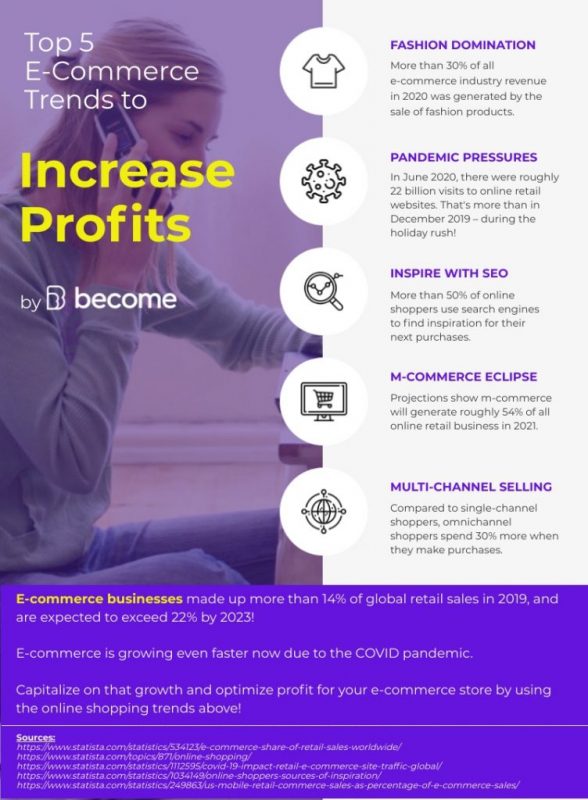
10 E-Commerce Industry Trends to Strengthen your Online Retail Store in 2021
Last year, retail sales generated by e-commerce businesses made up more than 14% of all global retail sales (approximately $3.53 trillion). But how are e-commerce industry trends looking for the future? For one thing, that 14% is expected to exceed 22% by 2023 and amount to almost $7 trillion.
Although e-commerce is growing even faster now thanks to the COVID pandemic, if you want to capitalize on that growth it’s not enough to just be operating in the e-commerce arena. You need to also stay on the up-and-up with online shopping trends that prove themselves to be valuable additions to your e-commerce store.
That’s what we’ll help you with today!
5 E-commerce industry trends with the biggest impact on your bottom line
- The dominance of fashion products
- Pandemic pressures
- Inspiring online shoppers via SEO
- The mobile commerce eclipse
- The power of multi-channel selling

1. The dominance of fashion products
Fashion products are at the top of the list in terms of revenue produced in the e-commerce arena. More than 30% of all e-commerce industry revenue in 2020 was generated by the sale of fashion products.
To put that into perspective, electronics and media (the next-highest product group in terms of revenue produced) comprised just a little more than 21% of total e-commerce revenue. E-commerce trends in 2021 aren’t expected to change very much with respect to which product groups generate the most revenue – take that into consideration when deciding what you sell on your e-commerce website!
2. Pandemic pressures
Traffic to retail e-commerce websites has absolutely boomed during the Coronavirus outbreak, reaching unprecedented heights. In June 2020, there were roughly 22 billion visits to online retail websites. Compare that to 20 billion visits in December 2019 – during the holiday rush!
Of course, these numbers are due to the fact that countless people across the world are under lockdown orders and many have no choice but to make purchases online even for the most basic of necessities like food and toiletries. While it’s not an ideal situation for anyone, your online business is in a position to help people in need while simultaneously improving your business profits.
3. Inspiring online shoppers via SEO
Recent survey data shows that more than half of the online shoppers who were surveyed used search engines to find inspiration for their next purchases. That means that if you want your online business to continue bringing in customers, you’ll need to invest in developing a top-notch SEO strategy.
4. The mobile commerce eclipse
Maybe ‘eclipse’ is a bit of an overstatement, but projections show m-commerce will generate roughly 54% of all online retail business in 2021. And it’s not just about online shopping trends on mobile devices – mobile banking and mobile payments are also aspects of m-commerce that your business should start planning to take advantage of in the near future.
5. The power of multi-channel selling
If you’re running your e-commerce business through a single channel, you’re doing yourself (and your business) a great disservice. Research shows that, compared to single-channel shoppers, omnichannel shoppers actually spend 30% more when they make purchases. If you’re looking for online shopping trends to raise your business’s bottom line, make sure to employ multi-channel selling!

5 E-commerce industry trends that you need to consider in 2021
- Alternative payment methods
- Influencer marketing
- Augmented reality (AR)
- Voice commerce
- AI integration
1. Alternative payment methods
Even with new/alternative payment options becoming increasingly available for online shoppers, credit and debit cards are still the most popular form of payment for online retail transactions in the Americas (for now!).
By 2023, it’s estimated that more than 52% of all online transactions around the globe will be conducted through digital wallets. Including alternative payment methods on your website can help improve your e-commerce conversion rates by giving customers more flexibility and more options to make purchases from your store.
2. Influencer marketing
You don’t need to be an expert on the products you offer in order to make sales. What you can do instead is search for people who are experts and have them advocate for your business. That’s essentially what influencer marketing is!
Not entirely convinced that it’s a valuable addition to your social media marketing strategy? A MarketingDive study found that nearly 90% of marketers use influencer marketing and that roughly 40% intend on increasing the budget for their influencer marketing strategy. Keep up with your competition and explore the possibility of getting some influencers on-board to help boost your bottom line!
3. Augmented reality (AR)
This e-commerce industry trend may seem a little far-out at first glance, but we assure you this is one online shopping trend your business doesn’t want to miss out on. When you hear the term AR, you might first think about those big funny looking goggles that produce a fully-immersive simulated experience for the user. But there are other forms of AR that are much more feasible and are already taking the e-commerce industry by storm.
Here are some examples of how you can use AR in your e-commerce store:
- Cosmetics – customers can now preview how a certain product may look on them before they actually buy it. Hair dyes, lipsticks, mascaras, and all other types of beauty products can be previewed through AR.
- Clothes & Accessories – by integrating AR capabilities into your online store, your customers can take a check out how a product looks on them before buying. That could include clothing, glasses, watches, shoes, and basically anything you may be selling.
- Furniture – when customers are curious about a new sofa or a new lamp, but they’re not confident about whether or not it will fit in their homes, augmented reality can allow them to make a determination without having to first make a purchase.
4. Voice commerce
“Hey Alexa, order me a pair of the new Nikes in a size 11!” Okay, the technology might not be that exact just yet, but we’re not far off. And while you may think that this sort of advanced e-commerce trend for 2021 isn’t designed for smaller businesses, you’d be wrong.
Since larger companies tend to be slower to adopt new technologies, small and medium-sized businesses may very well be able to incorporate voice commerce into their business models quicker, easier, and more efficiently than their corporate counterparts. With an estimated 23.5 million online shoppers expected to make at least one purchase via a smart speaker in 2021, it’s clear that this is a burgeoning e-commerce industry trend you shouldn’t bypass.
5. AI integration
Artificial intelligence (AI) is one e-commerce trend for 2021 that is absolutely brimming with the potential to transform the e-commerce arena. One study found that online companies that integrated some form of AI into their business model enjoyed gross profit margins 50% higher than companies that didn’t.
How can your business use AI? Here are some examples:
- Image search – allows customers to search for items by entering an image instead of a worded search query
- Facial recognition – allows businesses to track where customers spend more time on their website, giving them insights on what items to suggest on the customer’s next visit
- Improving customer support – AI allows your business to go beyond the ‘normal’ ways of providing support for customers. Chatbots might not be a big newsflash for you, but they do a whole lot to help track customer behavior, collect important data points, and reinforce brand identity – all of which serve to increase conversions.

Understanding online shopping trends and their effect on your business
It’s exciting and interesting to think of all the ways that the e-commerce industry trends listed above can impact the success of your online business. But how can you actually measure that impact?
It goes without saying that the more online shopping trends you include in your business model, the more confusing it can be to keep track of how each one is affecting your bottom line. At the end of the day, you don’t want to be pouring money into e-commerce industry trends if they aren’t returning value to your business.
In order to measure the impact that e-commerce trends of 2021 have on your business, you’ll need to quantify how much you’re investing in those trends and how much money they’re bringing back. Luckily for Shopify sellers, there’s a new Shopify calculator app that does exactly that.
BeProfit – Profit Tracker is a Shopify profit calculator app that tracks and analyzes your Shopify store’s profits and expenses, and then presents that information in an easy-to-digest dashboard. With the BeProfit profit margin calculator you can now understand complex data from your Shopify store at a glance so that you can optimize your business and increase your profits.
Feeling trendy?
By now, if you aren’t feeling at least a little bit trendy, then we’re a little bit concerned… In all seriousness, the list above is just a small sample of the e-commerce industry trends available at your business’s disposal right now. Yes, these trends will shift and change – and we’ll be sure to keep this list up to date. But the question remains: Which e-commerce trends of 2021 will your online business use?


 Please wait...
Please wait...




